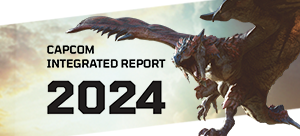Stock Quote
Management Strategy
Here you can find an itemized listing of our directors’ fundamental management policies, which include our basic corporate philosophy, management performance metrics, dividend policy, mid- to long-term strategies and challenges faced by management.
Forward-looking statements in the text below are based on the judgment of the Capcom Group as of the end of the previous consolidated fiscal year.
1. Fundamental Management Policy
Based on our Corporate Philosophy, the Capcom Group aims to maintain the group’s strengths, and achieve stable growth and enhanced corporate value over the medium- to long-term.
It will do so by ensuring transparency, fairness and speed in businesses, as well as by working towards mutual prosperity and building a relationship of trust with stakeholders (which include shareholders, customers, business partners and local governments).
[Corporate Philosophy]
Capcom is a creator of entertainment culture who aims to develop software content that excites and stimulates the senses.
[Strength of the Capcom group]
- A financial base for making proactive strategic investments attributable to a stable cash position and improved capital efficiency
- Production of content (IP) that is supported worldwide and multifaceted activities thanks to our unique, high-level technological and developmental capabilities
- A global, long-term sales system based on a digital strategy for further increasing profits
2. Key Performance Indicators
At the Capcom Group, management’s objective is to increase corporate value through the sustainable growth of its businesses.
In addition to measuring performance with a medium-term management goal of 10% increased operating income per fiscal year, the Company strives to enhance corporate value from a capital efficiency perspective by improving return on equity (ROE), while at the same time focusing on cash flow management. Further, Capcom is working to maintain a consolidated dividend payout ratio of 30% as its basic policy while continuing to make stable dividend payouts, after giving due consideration to matters such as future expansion and changes in the business environment.
3. The Business Environment and Medium- to Long-Term Management Strategy
The business environment is undergoing significant changes: the transition to high-speed, high-capacity mobile communication standards, more distribution channels for content, diversification of devices, and the expansion of the global gaming user base. In such an environment, the Company has achieved its medium-term management goal of achieving 10% annual growth in operating income for 10 consecutive fiscal years. Looking ahead, it will strive to captivate people throughout the world with best-in-class entertainment. At the same time, it will seek to further expand the reach of its content in the over 220 countries and regions in which it sells games by enhancing its brand and attracting new users.
For this reason, the Company aims to achieve 100 million units in annual sales in its core Digital Contents business by strengthening its long-term pricing measures and global sales via enhanced marketing attuned to the characteristics of different countries and regions while working to understand user needs.
Moreover, the Company will strive to develop the Arcade Operations and Amusement Equipments businesses by using popular IPs and major content, as well as uncover latent users and maximize profit-earning opportunities by raising awareness of IPs through investment in and leveraging of film and television productions, licensing merchandise, and esports.
In addition to the above strategies, the Company will continue its efforts to achieve its medium-term management goal by promoting its human resources investment strategy, which will be the driving force for the Company’s sustainable growth, and by strengthening investments in its development system and environment to increase its product pipeline through the creation of new IPs and utilization of major existing IPs.
On top of its business activities, the Company is also working to contribute to regional, cultural, and technological development by sponsoring and participating in the Osaka Healthcare Pavilion, which is being exhibited by the Osaka Prefectural and City governments at Expo 2025 Osaka, Kansai, Japan from April 2025.
Through various activities, the Company will continue to work toward realizing its management philosophy of being a creator of entertainment culture that stimulates the senses and excites people through game entertainment.
4. Priority Business and Finance Issues
Based on the strategy laid out in 3 above, the Capcom Group will focus on the following areas in the next fiscal year:
(1) Strategies by operating segment for the fiscal year ending March 2026
For the next fiscal year, the Group will focus on the following points based on the strategy laid out in 3 above.
A. Digital Contents business
In the Digital Contents business, in addition to Capcom Fighting Collection 2 (for Nintendo Switch, PlayStation 4, Xbox One and PC) and Onimusha 2 (for PlayStation 4, Nintendo Switch, Xbox One and PC) in May this year, the Company will also launch Street Fighter 6 and Kunitsu-Gami: Path of the Goddess for the Nintendo Switch 2 in June. Additionally, the Company will strive to maximize profits and continuously increase its total unit sales volume by strengthening digital sales and promoting sales measures for catalog titles such as Monster Hunter Wilds, which was released in the fiscal year under review. Furthermore, the Company will continue to pursue brand enhancement and user growth by continuing efforts in esports with Street Fighter 6.
B. Arcade Operations business
In the Arcade Operations business, the Company will continue to expand its new store formats while pursuing steady openings and operation of stores. Moreover, the Company will work to maximize the appeal of its stores and create synergies with other businesses by holding live events and other activities. The Company plans to open 10 new stores in the fiscal year ending March 31, 2026.
C. Amusement Equipments business
In the Amusement Equipments business, the Company will steadily release new models of smart pachislo machines, which are driving the pachislo market, centered on popular IPs.
In the fiscal year ending March 31, 2026, the Company plans to sell 43 thousand units with the launch of 3 new models, including the release of Devil May Cry 5 Stylish Tribe in June.
D. Other Businesses
In the Other Businesses segment, in its eSports business, which leverages Street Fighter 6, the Company has formed a partnership with the Esports World Cup, an international esports tournament to be held in Saudi Arabia in the summer of this year. By establishing a cooperative framework between this tournament and the Company’s three tournaments, including the Capcom Pro Tour 2025, the Company will focus on driving wider awareness of Street Fighter 6 and enacting a variety of other measures to achieve growth in the global market.
In addition, the Company will pursue strategies that maximize its Single Content Multiple Usage strategy on a global scale in order to expand penetration of the Company’s IPs globally via activities such as promoting movie and television adaptations of its content and cross-industry collaborations.
Through the above, the Company will continue its efforts to maximize corporate brand value while expanding the branding of its content.
(2) Sustainability initiatives
Based on its management philosophy, the Company is working to achieve stable growth and enhance corporate value over the medium-to-long term through its business activities, while also proactively addressing common environmental and social issues in order to create a world in which everyone can enjoy games with peace of mind.
Through these initiatives, the Company aims to create a better future by building trust with all stakeholders, including customers, business partners, and employees, among others.
A. Human resources investment strategy
The Company has positioned initiatives regarding human capital, which is the source of corporate value creation, as one of its priority issues and has therefore established a Chief Human Resources Officer (CHO) to promote its human resources investment strategy.
The Company will continue to enhance its corporate value by implementing the following initiatives.
a. Securing and developing human resources to support the future
In order to enhance its development system—the source of its core competitiveness—and achieve its ongoing medium-term management objective, the Company recognizes the importance of bolstering its development workforce and enhancing productivity through investment in human capital. As such, in addition to continuing efforts to increase its workforce by more than 100 developers every year, the Company implemented various measures from 2022 onward to enhance its ability to recruit and retain employees, such as increasing the average annual base salary of full-time employees by 30%, establishing a more performance-linked bonus system, and introducing a stock-based compensation system for employees. As a result, the Company has secured 2,846 developers in its workforce as of March 31, 2025.
In addition, the Company will continue its efforts to attract top talent by raising the starting monthly salary for new graduates to 300,000 yen in April 2025, which will enhance Capcom’s recruitment competitiveness in terms of remuneration, as well as by promoting industry-academia collaboration initiatives and expanding mid-career recruitment channels.
Moreover, the Company has introduced mentor training and other programs for the early development of young employees to foster and strengthen the human resources that underpin its future.
b. Organizing and improving the working environment
In order to expand its development environment and facilities to accommodate the increasing scale of development and sophistication of technology, the Company is expanding its workforce and making growth investments, such as acquiring real estate as business assets.
In addition, it is focusing on cultivating a corporate culture of respect for human rights and creating a comfortable working environment while raising the awareness of its executives and employees through training and leveraging opportunities for direct dialogue between management and employees. The Company will continue to focus on creating a better working environment to prevent employee turnover and increase engagement.
c. Ensuring human resource diversity
In order for the Company to further expand the number of development personnel in the future, it is necessary to create an environment in which human resources with diverse backgrounds can maximize their abilities.
The Company, therefore, is making efforts to secure and develop diverse human resources through recruitment and evaluation, regardless of gender, nationality, age, and other attributes.
The Company aims to achieve the percentage of male employees taking childcare leave to at least 85%, as well as raising the gender wage gap to at least 88% by the end of March 2029, in addition to introducing a partnership system with more inclusive definitions of spouses and conducting nursing care seminars.
As of March 31, 2025, the Company employs foreign nationals from a total of 36 different countries. It has therefore introduced measures for foreign national employees, such as Japanese language learning and a special leave system for them to visit their home countries.
The Company will continue to promote various initiatives and establish programs to create an environment where employees from various backgrounds can flourish.
(Reference)
| March 31, 2021 |
March 31, 2022 |
March 31, 2023 |
March 31, 2024 |
March 31, 2025 |
|
|---|---|---|---|---|---|
| No. of employees (consolidated) | 3,152 | 3,206 | 3,332 | 3,531 | 3,766 |
| Of which, development personnel | 2,285 | 2,369 | 2,460 | 2,675 | 2,846 |
| Average annual salary (non-consolidated) (thousand yen) |
6,034 | 7,127 | 7,660 | 8,328 | 9,185 |
| Operating income per employee (consolidated) (thousand yen) |
10,975 | 13,384 | 15,249 | 16,165 | 17,466 |
| Turnover rate (non-consolidated) (%) |
3.9 | 5.4 | 3.5 | 2.9 | 2.8 |
| Paternity leave utilization rate (non-consolidated) (%) |
21.5 | 34.5 | 45.5 | 66.7 | 79.7 |
| Gender wage gap (non-consolidated) (%) |
79.4 | 82.9 | 85.4 | 83.8 | 82.8 |
(Note) All of the above figures are based on full-time employees only. The paternity leave utilization rate is calculated for all employees, including temporary employees.
B. Initiatives for reinforcement of information security
The Company sells its content in more than 220 countries and regions globally and recognizes that information has a significant impact on its corporate activities. As such, while responding to personal information protection legislation, it is also enhancing its response to legislation for the protection of minors being advanced worldwide. In addition, based on an awareness of the need to take measures against compounding cyber risks both in Japan and overseas, the Company is working to strengthen its information security system to comply with laws and regulations related to information security.
The Security Oversight Committee, an external advisory body, has been meeting regularly, and based on the committee’s advice, the Company has been building capabilities for ongoing system operations and monitoring, as well as early response and recovery in the case of emergencies, such as when unexpected security risks materialize. Going forward, the Company will continue to maintain and strengthen its information security structure based on the PDCA cycle.
In addition, the Company will strive to raise awareness of information security by providing education and training to its officers and employees and reporting the results to the Board of Directors.
C. Environmental initiatives
The Company’s Digital Contents business accounts for approximately 75% of its total revenue and primarily entails the development and sale of software. This means that the Company’s environmental impact and climate-related risks are lower than the general manufacturing industry. Therefore, the Company believes that the impact of climate change risks and profit opportunities on its business activities and earnings will be minimal.
However, the Company views addressing climate change as a challenge that requires the cooperation of everyone living on this planet. Based on this view, the Company leads its peers in the promotion of digital sales of its content, which is part of its efforts to conserve resources and curb CO2 emissions in manufacturing and transporting physical media, such as game disks. The Company is also working to reduce its environmental impact by implementing power-saving measures and recycling certain parts in the manufacturing and sale of pachislo machines.
Furthermore, as part of the Company’s environmental response, CO2-free electricity sourced from renewable energy has been introduced in Company-owned buildings and other facilities in the Kansai area. As a result, approximately 27% of the power consumed by the Company in Japan is now provided by renewable energy. Furthermore, the Company is working to reduce its CO2 output by introducing green power at its Tokyo branch and expanding the adoption of CO2-free electricity at its other business locations. Additionally, the Company is making efforts to further reduce its environmental impact with initiatives such as using its own data centers, where power-saving measures are in place, while also using major cloud and data center service providers that promote the use of renewable energy.
(3) Initiatives on corporate governance
The Company is continuously working to enhance its corporate governance to enhance the transparency and soundness of management, build a system that can respond to changes in the business environment, and raise its medium- to long-term corporate value.
In addition, it strives to build a relationship of trust and mutual prosperity with its stakeholders.
A. Strengthening corporate governance
The Company is working to strengthen the performance of the Board of Directors by ensuring the diversity of the Board and expanding opportunities for the active participation of external directors to achieve sustainable growth and raise corporate value over the medium to long term, while taking into account the perspective of our stakeholders.
In addition, the Company strives to strengthen the oversight functions of management through information sharing and mutual understanding by ways of the Nomination and Remuneration Committee, which is chaired by an external director (and comprised of a majority of external directors), and meetings to exchange opinions between internal directors and external directors.
The Company has promoted diversity on the Board of Directors by appointing one new female external director in 2024, bringing the number of female directors to two. In addition, with respect to the remuneration system for executive directors, the Company has worked to further share value with shareholders by linking remuneration more closely to its business performance and introducing a performance-linked stock remuneration system.
B. Strengthening the risk management system
The Company recognizes that it is essential to develop and operate a system that can appropriately assess and manage the risks arising from its business activities in order to achieve sustainable growth. Furthermore, each department should analyze, evaluate, and consider responses to their respective risks, and strive to prevent potential crises from occurring. It is also important to strengthen cross-organizational management systems for risks that could have a significant impact on the Company.
To this end, the Company will work to take organizational measures to develop a structure to assess and oversee risk management across the entire Company and report on the status of risk management to the Board of Directors. Through these efforts, the Company will strive to enhance its internal control system, including internal control initiatives and promotion of compliance, and ensure that corporate governance functions effectively.
-
-
January 27, 20263Q FY2025 Financial Results Announcement
-
December 22, 2025-January 26, 2026Quiet Period
-
December 08, 2025Integrated Report 2025 added.
-
 Integrated Report
Integrated Report-
IR Materials Download
-
IR Social Accounts
-
Top 5 Recommended Pages
- Platinum Titles
- Game Series Sales
- Quarterly Reports
- Integrated Report
- Consumer Business Sales Volume
(as end of Nov. 30, 2025)








